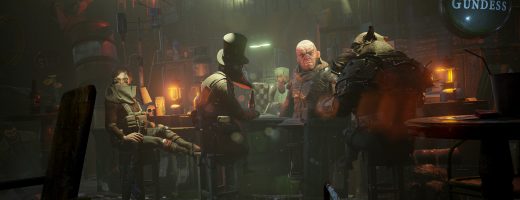Ravenlok Review
I’m Late! I’m Late! For A Very Important Date!
A game’s visuals aren’t the end-all-be-all but they can inform one’s first impression. Such is the case the eyecatching voxel style of Cococucumber’s Ravenlok. Considering the game revolves around a girl’s journey to save a whimsical Alice in Wonderland-esque world, the style helps set up the mood expected from this kind of story. It’s very clear that the game is a labor of love with a lot of care put into it. However, while Ravenlok’s looks score highly, the gameplay and narrative fall short of reaching the same level of imagination.
The story starts with a young girl who has just moved into a farm along with her parents, much to her chagrin as she is already missing her old friends. While exploring the family’s barn, she is pulled into a mysterious mirror that transports her into the realm of Dunia, a magical world currently under the rule of a tyrannical caterpillar queen. She is told by a talking rabbit named Finn that she is the chosen one known as Ravenlok, tasked with stopping the queen’s reign by collecting three special relics. This plot setup isn’t remotely original and, by itself, this isn’t necessarily a problem, but the story lacks compelling plot development and characters.
The main character doesn’t get much in the way of characterization outside of plucky young girl. She starts off unhappy about her new living situation, yet when she is pulled into Dunia, she has little reaction and instantly goes along with her new chosen status without any kind of hesitation. The story pacing means that plot beats occur without much time for them to breathe and a colorful supporting cast that doesn’t get much to do other than assist or hinder Ravenlok in her quest. Potentially intriguing darker elements are brought up only to be glossed over, which is a missed opportunity for a more engaging narrative.
If nothing else, Ravenlok’s art style catches the eye; doing a terrific job of giving a sense of wonder to the whimsical fairy tale world. Designs for the various inhabitants of Dunia are distinctive and varied for the game’s short playtime, with character models that bring to mind toy figures in a playset. This extends to the game’s many locations, from the steampunk flavor of the Clockwork Tower to the horror-tinged Greenhouse. The mundanity of the farmland the young girl’s family has moved into contrasts well with the visual wonder of Dunia. The music appropriately compliments the whimsical, yet slightly dark kid’s adventure tone of the game without ever calling attention to itself.
It’s rather unfortunate that the creativity shown in the visuals isn’t really matched in the gameplay. The player must obtain three relics from their respective locations, each one becoming accessible once players gain the necessary items to go there. These items are obtained by doing quests for NPCs or finding them hidden throughout the world, which requires the player to thoroughly explore each area. While this sounds simple enough, there are a couple instances where it is easy to miss an item necessary to get past a roadblock. There’s often no indication that an item found is required later on, and players may be forced to backtrack through previously explored levels if they have missed something needed down the line. Fortunately, areas are not overly large and players can fast travel between levels using mirrors that are scattered throughout, helping to reduce the time spent backtracking.
Players will spend most of the game switching between action combat, doing quests, and light puzzle-solving. Ravenlok uses her sword and shield to fight the various monsters that get in her way, complemented by a few special abilities that are given to her at certain points in the game, including a homing icicle spell, a charge attack, and a multi-slashing ability. Combat is perfectly functional but never rises above passable; regular fights often end up being monotonous slogs as sword attacks lack any real impact and feel mushy and unsatisfying. It’s not helped by how easy it is to stun enemies and remove the chance of them fighting back. Fights against groups don’t bring much challenge either, as they are often mindless and don’t offer much pushback. The shield — which has its own stamina meter — ends up being largely superfluous; there’s only one attack from a boss quite far into the game where it is truly helpful.
Bosses fare better than regular enemies in combat as they at least require the player to pay close attention to attack patterns to avoid damage. They are also surprisingly frequent considering the game’s short length and there’s enough variety to make them not feel stale, with a hydra, the Tweedle twins, and mechanical birds making up just a few of them. Although considerably more involving than standard battles, boss fights are still not overly difficult, as the player can easily have more than enough healing potions to brute force their way through.
Instead of automatically leveling up using the experience points given by enemies, the player has to return to the Witch’s House in an early in-game area to essentially buy levels. This makes leveling up unnecessarily time-consuming, especially as a single level can mean the difference between a boss fight going smoothly and becoming a tedious scratch fest. The level up system can be a frustrating early hindrance, as it’s very easy to run into the first boss before uncovering it.
Aside from combat, the player is asked to do quests for Dunia’s many inhabitants. A good deal of them are standard variety “collect/kill X of Y”, which gets tiresome when the player is asked to do several of them in a row to progress. These don’t take much time to do individually so the player is generally not doing them for too long, but they represent the disappointing lack of imagination in the gameplay. The light puzzle-solving is added in to occasionally vary things. These are simple tasks like entering a correct symbol/number combination or searching for a family of inanimate statues to light up, but are not really a particularly prominent part of the game and don’t add much.
Ravenlok is incredibly endearing on the surface with its charming visual style and vibe. It’s just a shame that the underlying game never completely lives up to that charm factor. With combat that ends up tiresome and an underwhelming story, there’s always a feeling that the game is missing something. The game fortunately doesn’t stick around too long, coming in at around six hours, but it’s disappointing that those six hours are not more memorable, as there are glimpses in Ravenlok that could have been something special.
Disclosure: This review is based on a free copy of the game provided by the publisher.


Endearing visual style
Decent bosses
Doesn't drag on
Rest of the game doesn't live up to the visuals
Combat becomes tiresome after a while
Unimaginative story









Recent Comments